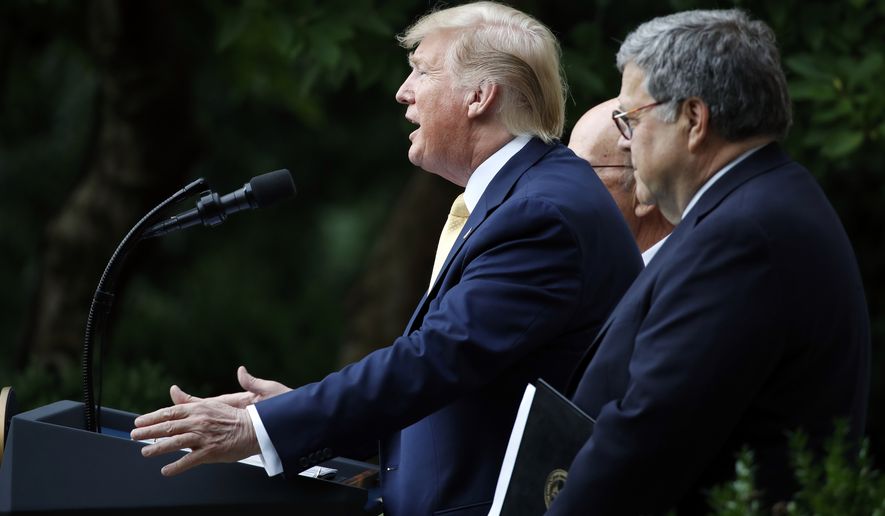President Trump on Thursday ordered the Census Bureau to try to figure out how many American residents are citizens — but ditched plans to include the question on the 2020 count, caving to political hurdles and legal realities.
Speaking from the White House, Mr. Trump said he was issuing an executive order to all agencies in the federal government to pool their existing data and send it to the Commerce Department, which will try to come up with a count without having to stick the question on the census itself.
Mr. Trump said it will be able to calculate not just citizens and non-citizens, but will finally produce a count of the illegal immigrant population.
“Far-left Democrats in our country are determined to conceal the number of illegal aliens in our midst,” the president said. “This is part of a broader left-wing effort to erode the rights of the American citizen, and it’s very unfair.”
Mr. Trump, flanked by Attorney General William P. Barr, said he felt he could have won the court battle over sticking the question back on the census, but said it would have required a drawn-out legal battle and even a delay of the 2020 count.
Instead, he bowed to legal and scheduling realities.
The back-down is a symbolic blow for Mr. Trump, who has invested an extraordinary amount of political capital in his crusade to get a citizenship question onto the census.
His political opponents cheered.
“This is a resounding victory,” said Melissa Mark-Viverito, interim president of the Latino Victory Project. “Now that we’ve won this battle, we must ensure that we maximize our communities’ participation in the census to ensure that everyone is counted.”
Immigrant-rights activists and Democratic leaders in blue states had been bracing for a long legal battle. They marveled at the president’s retreat Thursday.
“Trump’s attempt to weaponize the census ends not with a bang but a whimper,” said Dale Ho, an American Civil Liberties Union lawyer who’d argued in court against the question. “Trump may claim victory today, but this is nothing short of a total, humiliating defeat for him and his administration.”
Mr. Trump rejected that.
He said his new plan to ask agencies to dig into their files for information can still get him to the same place.
And he said the information can be made ready to release along with the results of the 2020 census.
“It will not stop us from collecting the needed information,” he said.
Trump critics pointed out that he’d had this option all along — and indeed, Census Bureau employees had suggested it as a better alternative than sticking the citizenship question on the 2020 count.
But the critics also said they’ll likely sue to stop this alternative, too.
“With this action, President Trump has effectively weaponized federal agencies like the Internal Revenue Service against our constituents as part of his white nationalist agenda,” said Rep. Jimmy Gomez, California Democrat.
Mr. Trump said all agencies will be asked to provide information, but the IRS, which has tax records for millions of illegal immigrants, could be an important source, along with Homeland Security databases.
The president also had thoughts for how the information might be used, such as doling out congressional seats among the states and drawing lines for legislative districts inside the states.
Even though illegal immigrants and other non-citizens can’t vote, they are counted for purposes of deciding how many U.S. House seats each state is allotted. Mr. Barr said there’s an ongoing legal debate over whether illegal immigrants can be excluded from that count.
“Depending on the resolution of that dispute, this data may possibly prove relevant. We will be studying the issue,” he said.
In one way, Mr. Trump’s new plan could produce more information. The citizenship question wouldn’t have produced the breakdown of legal versus illegal immigrants that Mr. Trump says he’ll now be able to get.
The question would have read: “Is this person a citizen of the United States?” Respondents were allowed to say they were citizens born in the U.S., citizens born in an American territory, citizens born abroad to an American parent, naturalized citizens, or did not have citizenship.
Asking a citizenship question on the main census is legal, and indeed has been done in previous decades. The question also still appears on other census surveys that are still used, but that don’t go to every household during the decennial count.
But Trump opponents said that immigrant and Hispanic communities have such fear of this administration that asking the question would scare them into not responding to the census. That could skew the eventual count, denying political power and money to areas with more immigrants.
Three federal courts ruled that while asking about citizenship was legal, the Trump administration cut too many corners.
The Supreme Court, in a 5-4 decision last month, agreed, calling the Commerce Department’s reasoning for rushing the question onto the 2020 count “contrived.”
Chief Justice John G. Roberts Jr. told the Commerce Department it could try a do-over. But the ruling came June 27, just three days before the June 30 deadline for beginning to print the questionnaire.
Last week, government lawyers told the courts they were conceding and would print the questionnaire without the citizenship question.
Mr. Trump, apparently, wasn’t consulted. He took to Twitter to blast his administration’s move, saying it wasn’t true. The lawyers then scrambled to tell the court they were rethinking.
In a stunning move, the Justice Department then tried to switch the entire legal team that had been handling the case. Judge Jesse Furman, one of the three judges who’s ruled against Mr. Trump on the census, refused to allow the switch, saying the department never gave any reason.
The Justice Department said Thursday it will once again tell the courts that the question is out.
• Stephen Dinan can be reached at sdinan@washingtontimes.com.




Please read our comment policy before commenting.